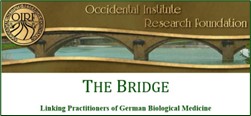POINTS OF INTEREST
Response to the Fukushima Nuclear Disaster
– Part 2
Sent: March-30-11
Email To: OIRF
Subject: Re: OIRF Report – Radiation
The hysteria around potassium iodide is inappropriate. The concern around radiation is not. Attached is an article of mine which Huffington Post picked up a couple of weeks ago. Here are the original version which names products and the “sanitized” version which does not name names but includes the references. If you would like to share these, you are welcome to.
James P. Blumenthal, DC, DACBN, FACFN
NeuroHealth Diagnostics, Inc.
To see Part 1 of this Response follow this link
To see Part 3 of this Response follow this link
To see Part 4 of this Response follow this link
Healthy Tips for Protecting Your Body from Radiation and Nuclear Fallout
I spent a bit of time online earlier today checking and responding to some Facebook sites that were discussing or looking for information on protecting ourselves from what appears to be the coming radiation from the reactor explosions and meltdowns following the tsunamis in Japan. One of the results was that I was asked to post some information to help all of us separate physiology from hysteria.
Let’s talk about protecting ourselves and our loved ones from the fall-out.
Most of the discussions I have seen so far are focused on taking iodine, particularly potassium iodide. So, let’s talk about the use of potassium iodide, also known by its chemical abbreviation “KI”. If you are within 10-50 miles of a reactor meltdown, radioactive iodine will connect to any and all iodine receptor cites that have no iodine in them. This is a serious problem because, according to Dr. David Brownstein [1], over 90 percent of people in North America are iodine deficient. This leaves them incredibly vulnerable to radioactive iodine, which is one of the principle forms of radiation given off in nuclear accidents and from nuclear weapons.
By taking a dose of about 130 mg of KI, the receptor sites are filled and there is nowhere for the radioactive iodine to be absorbed. As Dr. Leah Remeika Dugan describes it, KI fills up all the chairs and when the music stops, there is nowhere for the radioactive iodine to go. This sounds like a good idea, except that KI-dosing is only effective for about 24 hours and doing it more than twice starts pushing the envelope of toxicity [2]. Doing it even once is likely to make real trouble for anyone with Hashimoto’s thyroiditis [3]. Since KI is rapidly going into short supply across America and unless you are in the immediate vicinity of a nuclear accident, this is really not an effective strategy.
On top of that, iodine 131 has a half-life of about 8 days and uranium and cesium have half-lives measured in decades [4], so what do we do after the first 24-48 hours? Let’s look at a few other strategies.
“Roll, duck, and cover”, popularized in the 1950’s, doesn’t work, and the use of plastic and duct tape, suggested a few years ago by one-time FEMA head Tom Ridge [5], is also pretty ineffective.
That said, there are some things which we can do to help strengthen and protect ourselves from the inside out. Two of the body parts most sensitive to radiation are the thyroid and the kidneys.
Beyond the use of iodine, one of the few things which will actively protect the thyroid from longer term exposure to radiation, like what we can expect from the Japanese reactors, is the body’s most powerful anti-oxidant: Glutathione. The thyroid uses glutathione, a combination of three amino acids (glycine, glutamine, and cysteine), protectively as an antioxidant or free radical quencher and as a cofactor that makes it possible for one of its most important enzymes (5’-deiodinase) to work [6]. If we try to take glutathione as a supplement, it doesn’t work very well because it’s a big molecule that has trouble getting through the small intestine and into the blood stream and the body has to break it down into its three parts then reconstitute it on the other side once absorbed [7]. That is a lot of work and expense and inefficiency. One alternative is to supplement the three amino acids individually or in a combination.
Another is to use a transdermal glutathione cream which can actually cross the skin and enter the blood stream [8, 9]. Ideally, look for a cream that combines glutathione with the two other major free radical quenchers, SOD and Catalase. My family and I are taking a combination of the aminos and using the transdermal cream. Along with the glutathione precursors, it is a good idea to take a source of methyl-selenium-cysteine which helps the glutathione keep working. You don’t need to take more than about 200 micrograms (mcg) of selenium per day and it starts getting toxic at 4-5 times that level [10]. There are a number of brands of methyl-selenium-cysteine (not to be confused with seleno-methionine which does not do the same thing). Some are available in health food stores and some are available through functional medicine doctors’ offices.
The other remedy is one of the oldest, least expensive, most readily available remedies in this country. It has been used for years by the military to protect soldiers’ kidneys from uranium and cesium exposure and you can pick it up in any market and most convenience stores across North America. In fact you may already have some in your refrigerator RIGHT NOW. I am talking about sodium bicarbonate or, as most of us know it, baking soda. Yup, good old Baking Soda that may already be hiding in the back of your refrigerator and that you can pick up almost anywhere – for less than $2 a box.
According to Dr. Mark Sircus of the International Medical Veritas Association [11]: “The kidneys are usually the first organs to show chemical damage upon uranium exposure. Old military manuals suggest doses or infusions of sodium bicarbonate to help alkalinize the urine if this happens. This makes the uranyl ion less kidney-toxic and promotes excretion of the nontoxic uranium-carbonate complex. The oral administration of sodium bicarbonate diminishes the severity of the changes produced by uranium in the kidneys [12]. So useful and strong is sodium bicarbonate that at Los Alamos National Laboratory in New Mexico, researcher Don York has used baking soda to clean soil contaminated with uranium. Sodium bicarbonate binds with uranium, separating it from the dirt [13]; so far, York has removed as much as 92 percent of the uranium from contaminated soil samples. If the bombs start dropping anywhere on earth, or if you live near a nuclear plant, you will want to have a large amount of sodium bicarbonate on hand. Minimum stocks should be 25 or 50 pounds. Normally I recommend someone start with using one pound of bicarbonate in a bath but that could easily be two or three pounds in an emergency situation. It is not a joke that one can get 50 pounds of the most powerful medicines on earth for 35 bucks. You will also need a lot of magnesium salts and the very best and most penetrating of them is the magnesium chloride in the form of magnesium bath flakes. Dead Sea salt is also quite fine for this application.”
Spirulina and chlorella were also used heavily by the Russians after the Chernobyl nuclear plant disaster. The Japanese love their miso soup that was said to help some of their citizens survive the fallout after the bombings of Hiroshima and Nagasaki. Tan Koon Peng from Singapore writes: “Miso is effective for detoxifying your body of radiation. During World War II, two hospitals that were located side by side were hit with atomic radiation, in one hospital people consumed Miso and all of them survived while many people in the other hospital that did not take miso died. Miso is rich in vitamin B therefore it is suitable for vegetarians who are in shortage of vitamin B. For best results do not cook miso.”
 An Exclusive Article for Members
An Exclusive Article for Members
From THE BRIDGE Newsletter of OIRF
Published April 2011
© Copyright 2011, Dr. Jim Blumenthal, CA USA
References
- Brownstein, David, Iodine: Why You Need It, Why You Can’t Live Without It, 4th Ed. 2004
- CDC Emergency Preparedness and Response Potassium Iodide FAQ’s http://www.bt.cdc.gov/radiation/ki.asp
- Kharrazian, Datis, Why Do I Still Have Thyroid Symptoms When My Lab Tests Are Normal , 2010, M&J, New York
- Hyperphysics, Georgia State University http://hyperphysics.phyastr.gsu.edu/hbase/hph.html
- FEMA FAQ’s retrieved from http://www.ready.gov/america/other/faqs.html
- Huh K, Kwon TH, Kim JS, Park JM., Role of the hepatic xanthine oxidase in thyroid dysfunction: effect of thyroid hormones in oxidative stress in rat liver. Arch Pharm Res. 1998 Jun; 21(3):236-40.
- Hunjan MK, Evered DF, Absorption of glutathione from the gastro-intestinal tract, Biochim Biophys Acta 1985 May 14;815(2):184-8.
- Patidar V, Sharma D, Maliwal D, et al, Penetration Enhancement Techniques for Transdermal Drug Delivery System, Research J. Pharm. and Tech. 2(1):28-33 Jan-Mar. 2009
- Lamperti A, Ziskin MC, Bergey E, et al Transdermal absorption of radioprotectors in the rat using permeation-enhancing vehicles. Radiation Research. 1990 Nov;124(2):194-200.
- Behne D; Kyriakopoulos A; Gessner H; Walzog B; Meinhold H, Type I iodothyronine deiodinase activity after high selenium intake, and relations between selenium and iodine metabolism in rats. J Nutr, 122(7):1542-6 1992 Jul
- IMVA, http://sodiumbicarbonate.imva.info/index.php/kidneymedicine/radiation-protection
- Goto, K, A study of the acidosis, blood urea, and plasma chlorides in uranium nephritis in the dog, and the protective action of sodium bicarbonate. The Journal of Experimental Medicine, Vol 25, 693-719, Copyright, 1917, by The Rockefeller Institute for Medical Research New York jem.org/cgi/content/abstract/25/5/693
- Phillips EJ, Landa ER, Lovley DR, Remediation of uranium contaminated soils with bicarbonate extraction and microbial U (VI) reduction, J Ind. Microbiology (1995) 14, 203-207 http://www.geobacter.org/publications/J_Ind_Microbiol_1995_2.pdf



